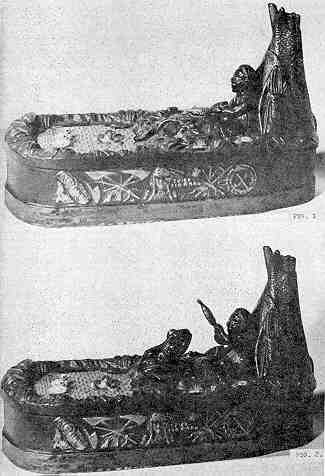Chief Big Moon
by F.H. Griffith - HOBBIES Magazine - March, 1965
 A number of mechanical banks are
somewhat obvious as to their action, that is to say when looking at the bank it is rather
obvious as to what will take place in the mechanical operation of the parts in connection
with the depositing of a coin or operating the lever. Transversely, there are a certain
number of mechanicals which one could refer to as a "surprise" group. These are
very interesting and entertaining banks as their action parts are often concealed and
nothing is apparent as to what the bank does. Banks of this nature have a very definite
appeal and are of particular interest to the writer. One of the best of the surprise type
banks is Chief Big Moon, our choice as No. 128 in the numerical classification.
A number of mechanical banks are
somewhat obvious as to their action, that is to say when looking at the bank it is rather
obvious as to what will take place in the mechanical operation of the parts in connection
with the depositing of a coin or operating the lever. Transversely, there are a certain
number of mechanicals which one could refer to as a "surprise" group. These are
very interesting and entertaining banks as their action parts are often concealed and
nothing is apparent as to what the bank does. Banks of this nature have a very definite
appeal and are of particular interest to the writer. One of the best of the surprise type
banks is Chief Big Moon, our choice as No. 128 in the numerical classification.
Chief Big Moon is an outstanding example of the clever ingenious design work of Charles A. Bailey. How he ever thought up or dreamed some of his designs for mechanical banks we will probably never know, but he certainly had a real knack for utilizing unusual and clever subject matters including political, satire, and so on. Bailey patented the bank August 8, 1899 and assigned the patent to the J. & E. Stevens Company of Cromwell, Conn., the manufacturers. The bank as produced by Stevens follows the patent drawings in practically every detail. A rare handwritten letter by Bailey covers the transfer of right and title of Chief Big Moon to the Stevens Company. For details of this letter please refer to the special article on Charles Bailey in HOBBIES for February, 1963.
The bank pictured is completely original and the paint is in practically mint condition. Colors are as follows: the sides of the base are a brown gold with a wide silver rim around the bottom, the decorations on each side which include a papoose, tomahawks, peace pipe, Indian Chief bust, the name "Chief Big Moon," and other things are in silver. The top part of the base representing woodland is in green highlighted with bronze and gold, and a couple of blue and white flowers. The rippling blue lake has two white ducks thereon and water lilies are white with green leaves. The large frog normally concealed under the lake is dark green with large yellow eyes and black pupils. His underside is yellow and his mouth red. The figure of the squaw is reddish brown, she has long black hair, and her clothing is yellow. The fish in process of being cooked over the campfire is silver, and the brown tepee has considerable design and figure work inscribed thereon.
To better illustrate the surprise feature of Chief Big Moon, it is shown in two photographs—Figure 1, before operation, and Figure 2, after. As shown in Figure 1 a coin is placed in the provided slot just to the front of the fish’s tail. Near the coin and somewhat hidden, a lever (not discernible in either photo) is then lightly touched, immediately the large frog springs from under the lake toward the fish. However, the Squaw lifts the fish up away from the frog, as shown in Figure 2. The coin meantime has been automatically deposited inside the bank, its position replaced by the figure of the frog. All parts are returned to their positions as in Figure 1 by lifting the lake (which tilts back) and pushing the frog on back and under the lake top. The weight of the lake top, which acts as a trap door, holds the spring balanced mechanism of the frog in place. As mentioned before, this is a very clever well designed bank—one of the best.
In closing, two points of interest are in order. For one, the patent papers explain Bailey’s original intent in the way the bank should be operated with a coin. Actually the coin should be pushed into the slot and the frog in moving into position above the coin slot will then strike the hand of the operator affording additional surprise or amusement. This was intended to be an inducement to use coins to operate the bank. The lever as we use it today was originally provided for the sole purpose of operating the bank as a mechanical toy when no coins were available. In other words, Bailey’s provision for the lever was only so the bank could be operated without a coin—not to operate the bank when using a coin. Secondly, the bank was originally called the Indian Camp Bank in old Stevens catalogs and advertised as such. The name Chief Big Moon actually refers to the Indian bust itself which appears on each side of the bank. For years now, however, since this name is on the bank, it has been known as such.
